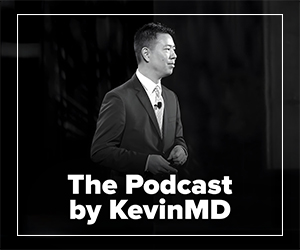Subscribe to The Podcast by KevinMD. Watch on YouTube. Catch up on old episodes!
Pediatrician Christina Suh discusses the KevinMD article, “More than just the flu: Helping families and doctors prepare for pan-respiratory viruses.” In this episode, Christina addresses the challenges of the current pan-respiratory season, including RSV, COVID, and the flu, emphasizing the critical role of vaccines in saving lives. She explores the concept of closing the intention gap to support individuals who want to get vaccinated by making the process easier, rather than focusing solely on vaccine hesitancy. Christina highlights the overwhelming burden on health care providers to communicate complex vaccination guidelines and presents digital messaging strategies that effectively increase vaccine uptake without adding to provider workload. Additionally, she discusses the U.S. Department of Health and Human Services’ Risk Less. Do More. campaign and offers actionable strategies for health care systems to enhance patient engagement and improve vaccination rates.
Our presenting sponsor is DAX Copilot by Microsoft.
DAX Copilot, by Microsoft, is your AI assistant for automated clinical documentation and workflows. DAX Copilot allows physicians to do more with less and turn their words into a powerful productivity tool. DAX Copilot automates clinical documentation—making it available in the EHR within minutes—and clinical workflows, including referral letters, after-visit summaries, style and formatting customizations, and more.
70 percent of physicians who use DAX Copilot say it improves their work-life balance while reducing feelings of burnout and fatigue. Patients love it too! 93 percent of patients say their physician is more personable and conversational, and 75 percent of physicians say it improves patient experiences.
Discover AI-powered solutions for clinical documentation and workflows. Click here to see a 12-minute DAX Copilot demo.
VISIT SPONSOR → https://aka.ms/kevinmd
SUBSCRIBE TO THE PODCAST → https://www.kevinmd.com/podcast
RECOMMENDED BY KEVINMD → https://www.kevinmd.com/recommended
GET CME FOR THIS EPISODE → https://www.kevinmd.com/cme
I’m partnering with Learner+ to offer clinicians access to an AI-powered reflective portfolio that rewards CME/CE credits from meaningful reflections. Find out more: https://www.kevinmd.com/learnerplus
Transcript
Kevin Pho: Hi, and welcome to the show. Subscribe at KevinMD.com/podcast. Today we welcome Christina Suh. She’s a pediatrician, and she’s going to talk about the KevinMD article, “More than just the flu, helping families and doctors prepare for pan-respiratory viruses.” Christina, welcome to the show.
Christina Suh: Thanks so much, Kevin. I’m really excited to be here.
Kevin Pho: All right, let’s start by briefly sharing your story and journey.
Christina Suh: Yeah, so currently I’m a director of clinical affairs at a company called Phreesia. As you mentioned, I am a general pediatrician. Prior to coming to Phreesia, I saw patients in a pediatric primary care clinic for about 15 years. We served a low-income population here in the Denver, Colorado, area. Then I joined Phreesia about five years ago as the clinical subject matter expert in all things primary care, vulnerable populations, and public health.
Today, outside of my work at Phreesia, the other hat I also wear is that I sit on the Colorado State Board of Health. So I also have a foot in public health, serving the people of Colorado.
Kevin Pho: All right, and today’s article, of course, is relevant to public health: “More than just the flu, helping families and doctors prepare for pan-respiratory viruses.” Tell us what this article is about.
Christina Suh: Yeah, so let me talk a little bit about some of the work that Phreesia does, just to set some context for your audience. Our mission at Phreesia is really to make care easier for everyone. We do that by giving patients the tools and information they need so they can actively participate in their care and make informed decisions.
One of the tools we provide is the ability to show patients personalized messages related to a variety of preventive health behaviors—vaccinations being one of them. We had the ability to analyze our data on vaccination messages we’ve shown over the past few years, to see whether these messages were effective in getting shots in arms. We analyzed data for about 20 million vaccination messages. We were able to look at claims data to see the effect of immunizations—whether immunizations were received by patients who saw the messages versus a control group who did not see the messages.
We found that across those 20 million messages, there was about a two-time increase in incremental vaccinations in that exposed group versus the control. For some of the vaccine messages, that number was almost 10 times as many vaccinations. We’re really excited about these results because, as a company, we are very dedicated to keeping patients healthy and making sure they receive the care they need, including important immunizations.
Kevin Pho: To give us context, what are some of the absolute numbers in terms of vaccination rates before and after those text message reminders?
Christina Suh: Yeah, so it was 20 million messages that we looked at in total. We also had the opportunity to ask patients their thoughts on the messages they had seen. Almost half of the patients exposed to the messages said this was new information for them. As folks in the health care community, we assume this is not new news, but for a big part of those patients, it was. Importantly, almost two-thirds of the patients also said they were planning to speak with their doctor about those vaccinations—which, for me as a provider, is a really important next step. We want patients coming into visits ready to have questions and discussions, especially about things as important as immunizations.
Kevin Pho: So as a pediatrician, what were some of the obstacles you faced in terms of maximizing that vaccine uptake rate?
Christina Suh: I think, for your audience, they probably know there are a variety of reasons. There are families who are vaccine-hesitant, and a lot of factors play into that, with plenty of research going on in that space. But there’s also a group of families I remember seeing who might be “movable.” Maybe they haven’t gotten the flu vaccine for their child yet, or they’re late getting it, and it’s not because they don’t want it. It could be an issue of convenience, or they might just have some questions.
I remember seeing children later in the respiratory season who still hadn’t gotten their flu vaccine. Often, all it took was a conversation to answer a few questions, and then the family would agree to start the flu vaccine series. I remember those encounters being a breath of fresh air, because in primary care, it can feel like a grind day to day—especially when it comes to talking about immunizations. But those families are out there who aren’t against getting vaccinations; they just need more information and a little nudge. Providing a bit of information before they see their provider can be that nudge to tip them toward getting vaccinated.
Kevin Pho: What about the political climate in this post-COVID era? How has that affected the questions you’re getting about the flu vaccine and contributed to hesitancy?
Christina Suh: Right, there’s a lot being talked and written about in this space, and it’s hard to say which way things are going to go. We have seen a decrease in immunizations, and a lot of good research is happening to understand the drivers behind that. But I think it’s important to remember that it’s still critical to support patients by giving them information that is accurate and evidence-based, so they can have conversations with their providers. That doesn’t change for me. That remains the work we’re very interested in and dedicated to at Phreesia.
Kevin Pho: So talk to us about the text messages patients receive. What kind of information do they get?
Christina Suh: The information can be very simple, like: “You may be eligible to get your flu vaccine today,” or “You may be eligible to get your RSV vaccine.” We’re basically putting that information in front of patients—letting them know what they might be eligible for, the risks associated with diseases that these immunizations protect against, and strongly encouraging them to have a conversation with their provider. In some cases, we may connect patients with doctor discussion guides so they have an additional tool for a meaningful conversation with their provider during the visit.
Kevin Pho: Are these text messages to the public in general, or are they linked to specific practices that partner with Phreesia?
Christina Suh: Good question. In general, they’re for patients who are using Phreesia to check in for their visit. The bread and butter of what Phreesia does is support organizations with patient check-in. After patients finish their check-in process, they can opt in or opt out of seeing further messages. It’s those patients who have opted in whom we can show this information to.
Kevin Pho: And are we talking just about flu and RSV vaccines, or do you also address pneumonia and other vaccines?
Christina Suh: We can present messages across the board for all of the respiratory vaccines. I’ll share with you that just for this respiratory season, we’ve already delivered over 2 million messages, and that’s a combination of all the different respiratory vaccines.
Kevin Pho: The article also talks about the “Risk Less, Do More” campaign. Tell us more about that.
Christina Suh: We were really proud to partner on that campaign, which was focused on getting immunizations against respiratory viruses—specifically influenza, RSV, and COVID—into the arms of folks at high risk for severe disease. We’ve been delivering those messages, and it’s been a really exciting partnership.
Kevin Pho: In terms of next steps, where do you see these text messages or patient reminders going, and what are some potential future opportunities?
Christina Suh: We’re going to continue looking into the effectiveness of our immunization messages to make sure they’re truly resulting in more shots in arms. As a past immunization-delivery researcher, that’s something really important and near and dear to my heart. We’ll continue supporting patients and providers in driving these health behaviors so patients can stay healthy and achieve optimal health.
Kevin Pho: Do you ever get pushback from patients about being overwhelmed with messages from their health care clinician? Whenever patients go for a visit, they get text reminders for the visit, then multiple texts afterward for things like patient satisfaction surveys. Pharmacies also send texts about vaccines. Now they get more texts from companies like yours. Do you get pushback that this is notification overload?
Christina Suh: That’s a great question in today’s climate. I think Phreesia has been really good at developing best practices over the almost 20 years we’ve been around—finding that sweet spot of enough messaging but not too much. We focus on making the messages relevant to the person seeing them, because part of the overload can happen when you show people irrelevant messages. We have an excellent team and a strong playbook of best practices to mitigate that fatigue.
Kevin Pho: We’re talking to Christina Suh. She’s a pediatrician, and today’s KevinMD article is “More than just the flu, helping families and doctors prepare for pan-respiratory viruses.” Christina, let’s end with some take-home messages you’d like to leave with the KevinMD audience.
Christina Suh: Yeah, so I would say the main take-home message is to remember that patients may not have all the information. It’s easy for us to assume they do, but sometimes they don’t. It’s important to use all the tools in your toolbox to support patients with information so they can make decisions and have meaningful conversations with you about their health.
Also, think about how you support patients, especially in the realm of immunizations. For me, this is kind of an “all hands on deck” moment. Consider your business partners or vendors like Phreesia, who may have solutions and are equally dedicated to supporting patients in the same way you are. We’re here and happy to partner to keep patients healthy.
Kevin Pho: All right, Christina, thank you so much for sharing your perspective and insight, and thanks again for coming on the show.
Christina Suh: Thanks so much, Kevin. I appreciate it.


























